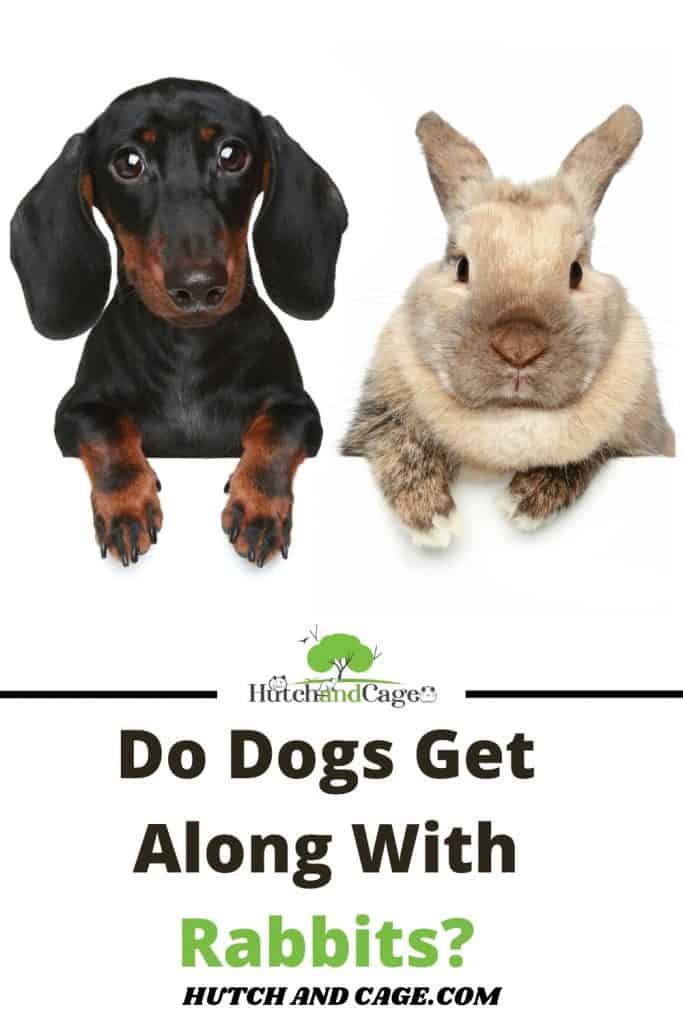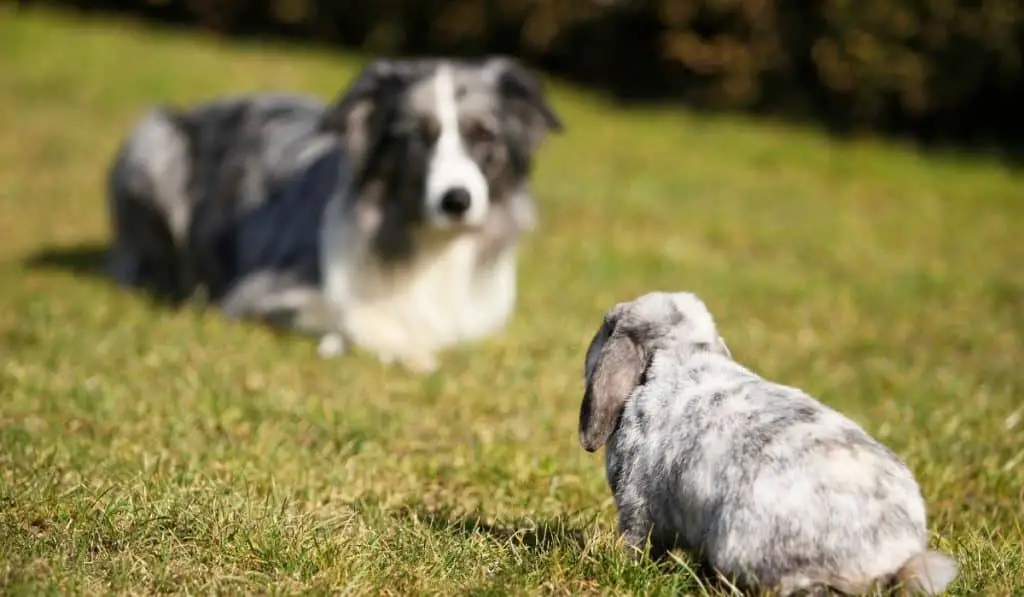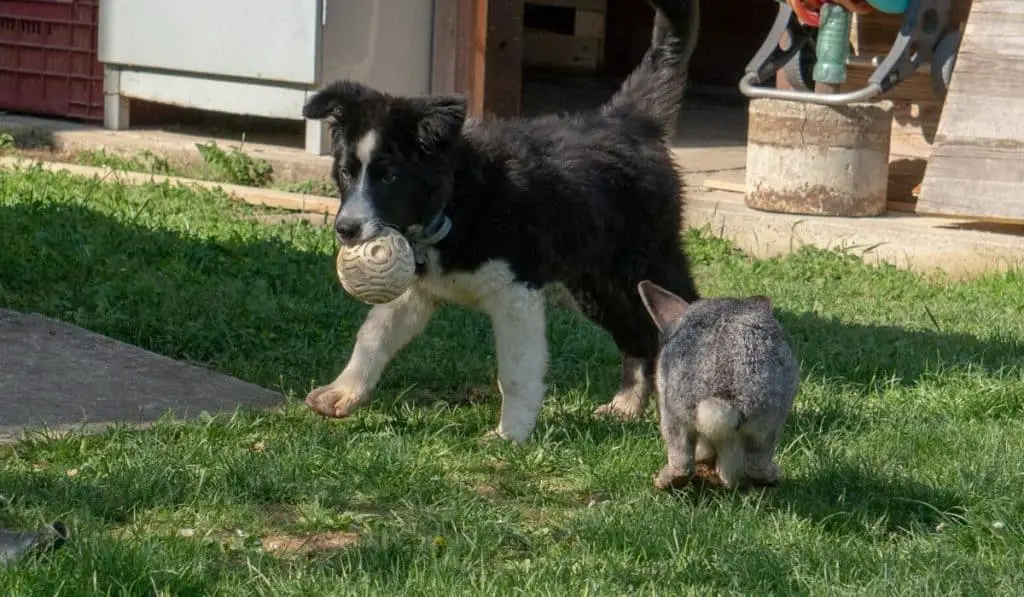Is it possible to bring dogs and rabbits together in harmony? Do rabbits and dogs get along?
This question has no single answer: It depends a lot on the personality of both. However, the dog’s personality is paramount, which only you; the dog owner can tell.
The general rule does not recommend keeping an animal born for hunting and a shy herbivore together since it is a typical prey of any carnivore.
Do Rabbits and dogs get along? Rabbits are animals that are easily stressed and a dog can be a real danger to physical safety, constant psychological stress, and as a perpetually looming threat. The possibility of coexistence depends largely on the dog. Also, its size, its nature, and the degree of obedience.
You must exclude cohabitation of your dog with your rabbit in all cases where: The dog is disobedient, impetuous, too lively, or aggressive – even if small in size.

Regarding the age, a puppy can be educated to respect the rabbit and consider it a member of the house just like all other family members.
An adult dog has already a trained personality and can have its own ‘opinions’ regarding the introduction of your cute bunny.
A docile, obedient and good-natured dog is a better candidate for coexistence, but caution is always required in letting the two come close.
To leave them together without supervision, it is necessary to have acquired absolute confidence in the behavior of the dog over time.
Table of Contents
The Slow Approach
Sometimes a long internship is necessary; gradually approaching the two animals and carefully checking the reactions of both.
There are many cases of happy coexistence, but a minute is enough for a tragedy to occur. The dog must respond promptly to the commands of the owner, to be regarded as obedient and reliable.
Some types of rabbits are friendlier than others. For example, the Sussex breeds, the German rabbit, the Himalaya, Havana, or Californian.
If the rabbit will be the second pet you will bring indoors, try to choose one of these breeds.
A good presentation and educating the two animals, help maintain a respectful behavior, which are essential elements to keep these two beautiful pets in your home, without problems.

How to Encourage Coexistence Between Rabbits and Dogs
The following guidelines are designed to allow the rabbit and dog to get used to each other in a positive and safe environment.
Since each situation is determined by the personalities of the subjects involved, there is no “right way” to proceed.
As a general rule, it is better to proceed slowly, with caution, and be successful; rather than being in a hurry to get some results and risk disaster.
Initial knowledge can be done in several ways. If the rabbit is lively and very active and/or the dog is a bit turbulent and unruly, it is best to start by keeping the rabbit in the cage and the dog on a leash.
Most rabbits feel safer and more sociable when in their own area.
Encouraging with Praise
Encourage, praise, and reward every curious and kind attitude on the part of the dog: “Bravo Jack! Good okay! How good you are! What a good dog! “
In this way, the dog will learn to associate the word “good” with calm, with a calm and friendly interest, and that when it behaves like this it is praised/rewarded.
You can also use “good” later, if, for example, you become more excited and hyperactive, to bring it back to calm and control. In doing so, you teach it something positive, it says “yes”, instead of scolding it and feeding a negative attitude with “no”.
If the dog gets too excited, say “no!” and give it a slight tug on the leash, to get its attention. If it calms down, praise it and reward it.
If, on the other hand, you see that you have to correct its behavior several times, that you have to repeatedly call it to calm, then you are proceeding too quickly. You should probably work more on the dog’s obedience before getting it to meet the rabbit.
Expressions like “Stay down!”, “Good!”, “Good dog!” and “Great!” should become integral parts of its vocabulary.
The Ultimate Goal
The ultimate goal for the dog should be to crouch down and keep quiet, even if the rabbit runs and hops freely around the house. Work with the dog fluently, firmly, and gradually.
Take it one step at a time. Also, use the modeling technique with your dog: step by step. It could be demanding, but not impossible and the results can be truly exceptional. Try to put your dog in the best condition to succeed in this “endeavor”. Work with it.
A confident rabbit, a calm and peaceful dog could sniff nose to nose, without any cage to act as a shield between them.
Put the dog on a leash and have it lie down quietly; then bring the rabbit into the room and allow the two furry ones to look at each other, sniff each other, take a look around so that they become familiar with this new situation.
Never miss the opportunity to praise and reward the dog if it maintains a calm and peaceful attitude.

Continuing the Process
Proceed in the same way for several days and always be present during dog-rabbit encounters. This phase of insertion can last for a long time, from a few days to a few weeks, up to a few months. It is the animal subjects involved that dictate the times and methods.
Your job is to be present and alert and make sure that every individual (dog, rabbit, people involved) is truly ready before proceeding to the next level.
The following step may be to remove the leash from the dog; or leave the leash attached to the collar, but without holding it back.
Then you can let the dog free to get up from the ground, sit or stand so that the rabbit becomes familiar with this new position.
After that, you can allow your dog to take a few steps so that your rabbit gets used to him on the move and so on.
Why Teach Dog Obedience?
Training and education must never be coercion, an obligation, or a manifestation of one’s power over the animal.
I attribute to the term “train” to the meaning of “educate” and for me, this means “to communicate”.
To train, educate, communicate means to teach the animal, be it dog, cat, rabbit, or other, that the sounds that come out of my mouth have a meaning.
When I say “come here!” I am sending a message and, if I have done a good job and the intention is positive and is caught by the animal to which I am addressing, I expect the animal to understand the meaning of that message and behave accordingly.
A dog that has received positive, gentle, effective obedience training knows it can count on its human partner when facing a new and unknown situation. It knows it can rely on him (the same goes for a rabbit or any other animal).
A dog that doesn’t listen to you, ignores you, or freaks out if the slightest distraction occurs, is not a good candidate to befriend your rabbit.
The training should aim to build the relationship, the communication between you and your dog. That’s why it’s so important.
Final Thoughts: Do Rabbits and Dogs Get Along?
Should a dog live with a rabbit? Before adopting a rabbit, you must consider whether the dog can learn to live with it and respect it, or if it is an unreliable and dangerous animal.
If you have a rabbit at home already, always choose an obedient and calm-tempered dog, perhaps adopting one already an adult, whose character can be immediately assessed.
If a series of rules are respected, rabbits and dogs can get along. Follow the advice I have given you and you can have an even more cheerful and fun home, thanks to the affection of these two extraordinary and peaceful pets.




